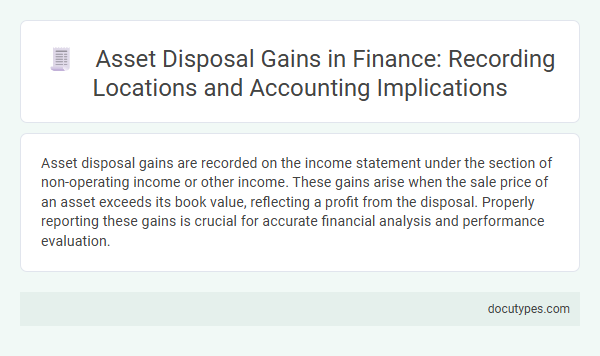Asset disposal gains are recorded on the income statement under the section of non-operating income or other income. These gains arise when the sale price of an asset exceeds its book value, reflecting a profit from the disposal. Properly reporting these gains is crucial for accurate financial analysis and performance evaluation.
Introduction to Asset Disposal Gains in Finance
Asset disposal gains represent the profit realized when a company sells an asset for more than its book value. Understanding where these gains are recorded is essential for accurate financial reporting and analysis.
- Income Statement - Asset disposal gains are typically recorded under non-operating income, reflecting profits from asset sales outside core business activities.
- Balance Sheet - The disposal of an asset adjusts the carrying value of assets, impacting the overall asset section of the balance sheet.
- Cash Flow Statement - Proceeds from asset sales appear in investing activities, showing actual cash inflows from the disposal.
Defining Asset Disposal and Gain Recognition
Asset disposal refers to the process of selling or discarding a company's fixed assets such as equipment, vehicles, or property. Gains from asset disposal are recognized when the sale price exceeds the asset's book value, reflecting a profit on the transaction. You will find these gains recorded in the income statement under "Other Income" or "Non-Operating Income," highlighting their impact on the company's financial performance.
Common Types of Asset Disposals
Asset disposal gains are recorded in the financial statements under the income section, often labeled as "Gain on Sale of Assets" or similar. These gains reflect the difference between the sale price and the asset's carrying value at disposal.
Common types of asset disposals include sales, retirement, exchange, and abandonment of assets. Sales occur when an asset is sold for cash or other consideration, generating either a gain or loss. Retirement or scrapping involves removing an asset from service without any proceeds, while exchanges swap one asset for another, sometimes recognizing a gain or loss on the transaction.
Accounting Standards Governing Asset Disposal Gains
Asset disposal gains are recorded in the income statement under other income or gains. Accounting standards such as IFRS and GAAP provide specific guidelines on recognizing and measuring these gains.
- IFRS Standards - IAS 16 governs accounting for property, plant, and equipment, requiring gains from asset disposals to be recorded in profit or loss.
- US GAAP Guidelines - According to ASC 610, gains from asset disposals must be recognized when control transfers and are reported in operating or non-operating income.
- Disclosure Requirements - Both IFRS and GAAP mandate detailed disclosure of asset disposal gains in financial statements to ensure transparency to stakeholders.
Journal Entries for Recording Asset Disposal Gains
Gains from asset disposal are recorded in the income statement under other income or gains. The journal entry for recording asset disposal gains involves debiting cash or accounts receivable and crediting the asset account and a gain on disposal account. Your accounting records should accurately reflect these entries to ensure correct financial reporting and compliance.
Financial Statement Presentation of Disposal Gains
Asset disposal gains are recorded in the financial statements to reflect the profit earned from selling fixed assets above their book value. These gains impact both the income statement and the notes to the financial statements for transparency.
- Income Statement - Disposal gains are reported under other income or non-operating income, highlighting their effect on net profit.
- Statement of Cash Flows - The cash received from asset sales is presented under investing activities within the cash flow statement.
- Notes to the Financial Statements - Detailed disclosures about asset disposals, including gains realized, are provided for additional clarity and compliance.
Recording asset disposal gains accurately ensures correct representation of company profitability and asset management in financial reports.
Impact of Disposal Gains on Profit and Loss Statements
Asset disposal gains are recorded in the profit and loss statement under the non-operating income section. These gains represent the excess of the sale proceeds over the book value of the disposed asset.
The impact of disposal gains on profit and loss statements is an increase in net income, enhancing the overall profitability for the reporting period. Accurate recording ensures clear financial reporting and aids stakeholders in assessing asset management efficiency.
Tax Implications of Asset Disposal Gains
| Aspect | Details |
|---|---|
| Where Asset Disposal Gains Are Recorded | Gains from asset disposal are recorded in the income statement under other income or gain on sale of assets. They reflect the financial benefit from selling an asset for more than its book value. |
| Tax Implications | Asset disposal gains are considered taxable income by tax authorities. The gain is calculated as the difference between the sale proceeds and the asset's tax basis. Tax rates applied depend on whether the gain is classified as short-term or long-term, affecting Your overall tax liability. |
| Reporting Requirements | Businesses must report asset disposal gains on relevant tax forms, such as Schedule D for capital gains in the U.S. Proper documentation of the asset's original cost, depreciation, and sale price is essential for accurate tax reporting. |
| Impact on Financial Statements | Besides increasing net income, asset disposal gains can affect retained earnings and shareholder equity. They provide insight into asset management efficiency and overall financial health. |
Internal Controls for Asset Disposal Transactions
Where are asset disposal gains recorded within financial statements? Asset disposal gains are typically recorded in the income statement under non-operating income or other gains. Your internal controls should ensure these transactions are accurately authorized, documented, and reported to maintain financial integrity.
Where Are Asset Disposal Gains Recorded? Infographic

